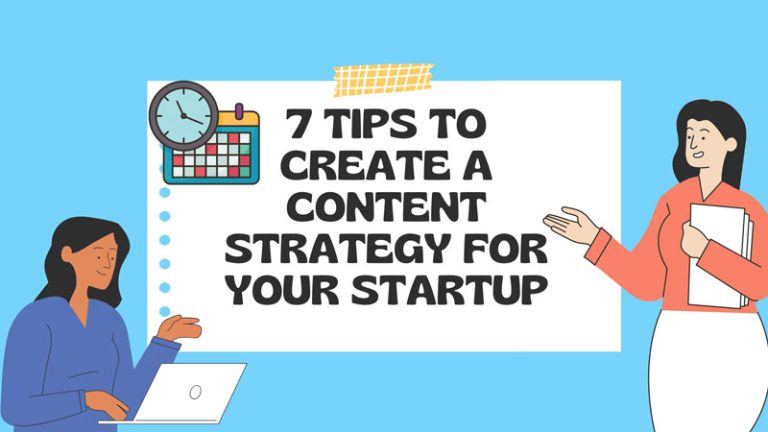
7 Tips To Create A Content Strategy For Your Startup
- November 22, 2022
- 4:11 pm
- Blog Posts

As a startup company, your resources are limited. Since you are already here, you are aware that a good content marketing strategy is excellent for business. But you may wonder how to be more cost-effective and efficient with your startup marketing strategies.
Chances are–you are strapped for cash, don’t have the resources to manage a large team, and are also in a time crunch.
Want to find out the best tips to help you create a great content strategy for your business? We have you covered. But before you jump on to that, do you know what makes a content strategy effective?
To make sure your brand sells and gets all the limelight, you need a robust digital marketing strategy that encompasses multiple channels. Then, you need to focus on creating the right type of content that attracts and resonates with your audience.
With the basics cleared, let’s move on to creating a successful content strategy:
1. Affordable Content Strategies with Free Tools
While being effective and powerful, your content strategy and the tools you use for its implementation can also be cost-efficient, or even free! You need a content strategy that is user-centric and comprehensive to address the audience on your website, emails, social networks, and other channels. The content you generate must be sufficient for your free and paid promotions across these channels.
But this doesn’t mean you need to splurge on several tools and software. With a low budget, nothing comes better than free tools. Turns out, to create unique marketing content, you don’t need high-end and expensive tools.
For example, Google Docs is the best tool for writing and sharing documents. And like most Google software, it’s easy to use and can be used for all stages of content strategy.
Moreover, after a bit of research, you can find free web tools and plugins for any and every kind of software to start. You don’t need to pay for them, but you might need to sign in to use them.
You also require software to publish your content, and if your content type is blogs, WordPress works best. It is suitable for all kinds of blogs and is user-friendly and accessible.
Once your business is growing, you can move on to set a reasonable budget for your content marketing, but for now, to do content marketing for small businesses, you can work with the free tools.
2. Manage Your Time

As mentioned earlier, when working on content marketing for startups, you are not only short on money but also time. Today’s entrepreneurs need to establish a lot. You don’t have enough hours to focus on all aspects of your business. So, you are required to hack your content strategy.
Time flies by quickly when you have a small team focusing on the responsibilities of marketing, production, and growth. To save time, you need:
● Bulk Creation
When you have new ideas, it’s ideal for you to work on all of them at once. The concepts stay fresh, making more sense for your business.
● Immediate Updates
Ask your team to keep you up-to-date with all the tasks that are done. This not only gives you a feeling of accomplishment but keeps you motivated to do more.
● Plan, Plan, Plan
Stop leaving work until the last minute. You would probably end up creating sloppy content and increasing stress.
● From Big to Small
Start with creating content that brings you the most ROI first. Then move on to the smaller tasks.
Talking about time, always remember that you need to be consistent and stay put for the long term. You need to be patient to see the results. Google takes about two consistent years of hard work until you can see your content strategy working incredibly.
Also, it would help if you started right now to save time later.
3. Audience is Important
Needless to say, you need to focus on your audience. Content marketing best practices include understanding your audience.
Your audience needs you to speak to them directly. To answer their questions and to know what their pains, frustrations, and desires are.
But how do you connect with your audience? The best way is to get their feedback by simply asking them. Once you know what your customers are struggling with, you must create content to answer their questions.
You can use Google Forms, a free tool, to attempt audience surveys.
If your business is skin-care related, for example, you need to ask your audience questions related to that. Your question can be something like
- What is your main concern when it comes to skincare?
- What is your skin type?
- How often do you do a skincare routine?
So on and so forth.
Let your audience know why you are doing this survey and how it will help them in the future. When they know that your content will help answer their worries, they will be more inclined towards doing the survey.
Remember, you need your audience to feel involved and cared about. Once the responses start pouring in, you will find golden ideas for your startup content strategy.
4. Document your Content Marketing Strategies
When it comes to startup marketing strategies, don’t be one of those people who don’t know how far they have come. According to research, 88% of B2B companies use content marketing of which only 20% have a documented content marketing strategy.
Google Sheets, another free tool, is amazing to help you keep track of everything you have been up to in your content marketing plan. Keep a note of the following:
- Content type
- Title
- URL
- A summary of what the content is about.
Add all old and new articles to the list and keep it up to date. This way, you will know what topics you have covered and which ones you missed.
5. Keep Your Content Fresh
A startup content strategy requires your content to be fresh, crisp, and out of the box. Depending on your customers’ needs, you need to brainstorm new ideas. Since we have an inventory of all your past content and information from the new surveys, it will be easy to create fresh content.
Cover all aspects, meet the needs and goals of your customers and answer the unanswered questions. Once you know what topics to work on, you must know which content to create. We will tell you the top 3.
● Listicles
Easy-to-do and popular lists are the best ways to work on your ideas. They are like bite-sized pieces of information, which is why readers love reading them. Plus, all you need to do is brainstorm a list and expand on those thoughts. BuzzFeed is one of the most viral sites when it comes to listicles.
● How-to Articles
Content should be based on solving your customers’ problems. When customers know that you have the solution to their problems, they become more inclined toward you. In a how-to article, you provide step-by-step instructions to help them. WikiHow is a popular platform that contains how-to articles.
● Success Stories
You can inform your potential customer’s success stories through a case study. Your clients will be able to relate to such content, knowing they are not alone in their problems and there is someone who can help them. According to research, 78% of buyers use case studies as proof to buy from a business.
The aforementioned content types can also be used in video, podcast, or even infographic marketing.
6. Stay Organized
Startup marketing strategies need to stay consistent and organized. Whether you are publishing one piece of content per day, per week, or per month, you need to stay consistent. Depending on your industry, you may not need to post frequent content, but you must be regular with it.
With the help of an editorial calendar, you can keep your content moving — from creating to editing to publishing.
There is free software you can use and share with your team where everyone can see what needs to be done and when. When your team is working on deadlines, you can stay more consistent and organized.
After successfully working on creating a consistent publishing schedule, you can work on increasing the volume of the content you create.
7. Consistent Editorial Guidelines

Every brand needs to develop a tone for the content they create. The content strategy for startups needs to include creating editorial guidelines.
If you have a good set of writers, you should know that writing and research are only the easy part of the process. However, you should know everyone writes differently.
Due to inconsistent writing, your brand’s voice may not be consistent. Some writers have a more formal writing tone, while others use an easy-to-read conversational tone. While others are more comfortable writing in first-person voice, some use second or third-person.
If a reader is going through your website, they would prefer reading content in the same tone, but how do you do that?
You need to create an editorial guideline. And while you do that, focus on the following:
- How do you want your tone to be? Loud and sales-y or calm and conversational?
- How do you need to structure the articles? Note down which sections need to be included where.
- How should writers submit their articles? Do they share links with you, email you a document, or are they required to publish directly?
So, even if it’s just you dealing with the content writing, you need to have guidelines to keep you on track.
Final Thoughts
Whether hiring a content marketing agency or working on startup strategies, you can use these topics to help you create killer content. Build a great content marketing strategy with little to no budget using our tips. Content enables you to increase conversions and drive customers to your business.
So, to sum it up, using free tools and staying consistent and up-to-date is all you need to ignite your success.








